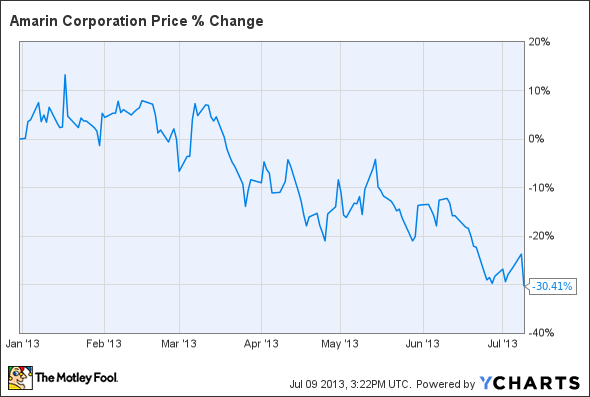Amarin Shares Sink on Secondary Offering
"More means less." Amarin demonstrated this seemingly contradictory maxim today following its announcement of a new public offering. Shares promptly sank by 8%. With more shares on the market, the less each share is worth. Let's take a look at the details.
Adding up the ADSs
Amarin plans to sell 21.7 million American Depositary Shares, or ADSs, in a public offering. The underwriters of the sale will also have a 30-day option to purchase another 3.255 million shares. The shares will be offered at prevailing market prices.
There are currently 150.7 million or so outstanding shares of Amarin's stock. This new offering represents around 14% of outstanding shares, with the option available to underwriters making up another 2%. In one sense, a drop of only 8% with potential share dilution of twice as much doesn't sound too bad.
As of the end of March, Amarin had cash and equivalents of a little more than $203 million. Why have another public offering now? The company wants to use the proceeds generated to fund its continued commercial launch of triglyceride-lowering drug Vascepa. At the current pace it's burning through cash, Amarin will need more in 2014. It's better to take care of business sooner rather than later.
Tale of two charts
Amarin's recent history is basically a tale of two charts. The company's decision to launch Vascepa on its own has taken a toll on its stock. However, the good news is that Vascepa sales have been climbing.

Source: Company SEC filing.
It should be noted that the June prescription number for Vascepa comes with a couple of caveats from the company. The last two days of the month aren't included in the total. Also, the figure is based on weekly compilations of data, which Amarin says tend to understate the number obtained later in the monthly compilation.
Why have share prices continued to fall at the same time that Vascepa sales have grown? In large part, the answer boils down to skepticism.
Many are skeptical about Amarin's ability to successfully commercialize Vascepa to its full potential against larger competitors with fish-oil pills. GlaxoSmithKline markets Lovaza and has made nearly $3.8 billion from the drug over the last five years. AstraZeneca bought Omthera Pharmaceuticals in May, primarily to gain its fish-oil drug Epanova.
Some are skeptical about Amarin's prospects for obtaining approval to sell Vascepa for treating individuals who have triglyceride levels between 200 and 500 mg/dL. While the drug is approved for people with very high triglyceride levels, the market for this lower-yet-still-high triglyceride level range is 10 times larger.
There is also skepticism in the physician and payer community about the real health benefits of prescription fish-oil drugs. Several clinical studies have had less-than-stellar results.
To be fair, though, studies of Vascepa showed solid results in lowering triglyceride levels. Unlike Glaxo's Lovaza, it did so without raising cholesterol levels. And while analysts expect Lovaza sales to decline this year, Amarin continues to report higher sales for Vascepa.
AstraZeneca and Omthera only recently submitted a New Drug Application for Epanova in treating patients with very high triglyceride levels of 500 mg/dL and above. Meanwhile, Amarin moves ahead with marketing to that patient population while it awaits possible approval for a much-larger market. A decision by the Food and Drug Administration is scheduled for Dec. 20.
Foolish take
I suspect that the company will continue to report increasing Vascepa sales numbers. There also appears to be a reasonable chance that the FDA will approve the drug for individuals with high (as opposed to very high) triglyceride levels later this year. Amarin's shares could very well be much higher by year end.
For now, though, I'd recommend a "more means less" strategy. Wait for a little more certainty about the market for Vascepa -- and take less profit.
Like many biotech and pharmaceutical stocks, Amarin carries considerable risk. Of course, it also brings the potential for significant rewards in exchange. It's good for investors to balance stocks like Amarin with others that have less risk, like solid dividend stocks. If you're on the lookout for high-yielding stocks, The Motley Fool has compiled a special free report outlining our nine top dependable dividend-paying stocks. It's called "Secure Your Future With 9 Rock-Solid Dividend Stocks." You can access your copy today at no cost! Just click here.
The article Amarin Shares Sink on Secondary Offering originally appeared on Fool.com.
Fool contributor Keith Speights has no position in any stocks mentioned. The Motley Fool has no position in any of the stocks mentioned. Try any of our Foolish newsletter services free for 30 days. We Fools may not all hold the same opinions, but we all believe that considering a diverse range of insights makes us better investors. The Motley Fool has a disclosure policy.
Copyright © 1995 - 2013 The Motley Fool, LLC. All rights reserved. The Motley Fool has a disclosure policy.


